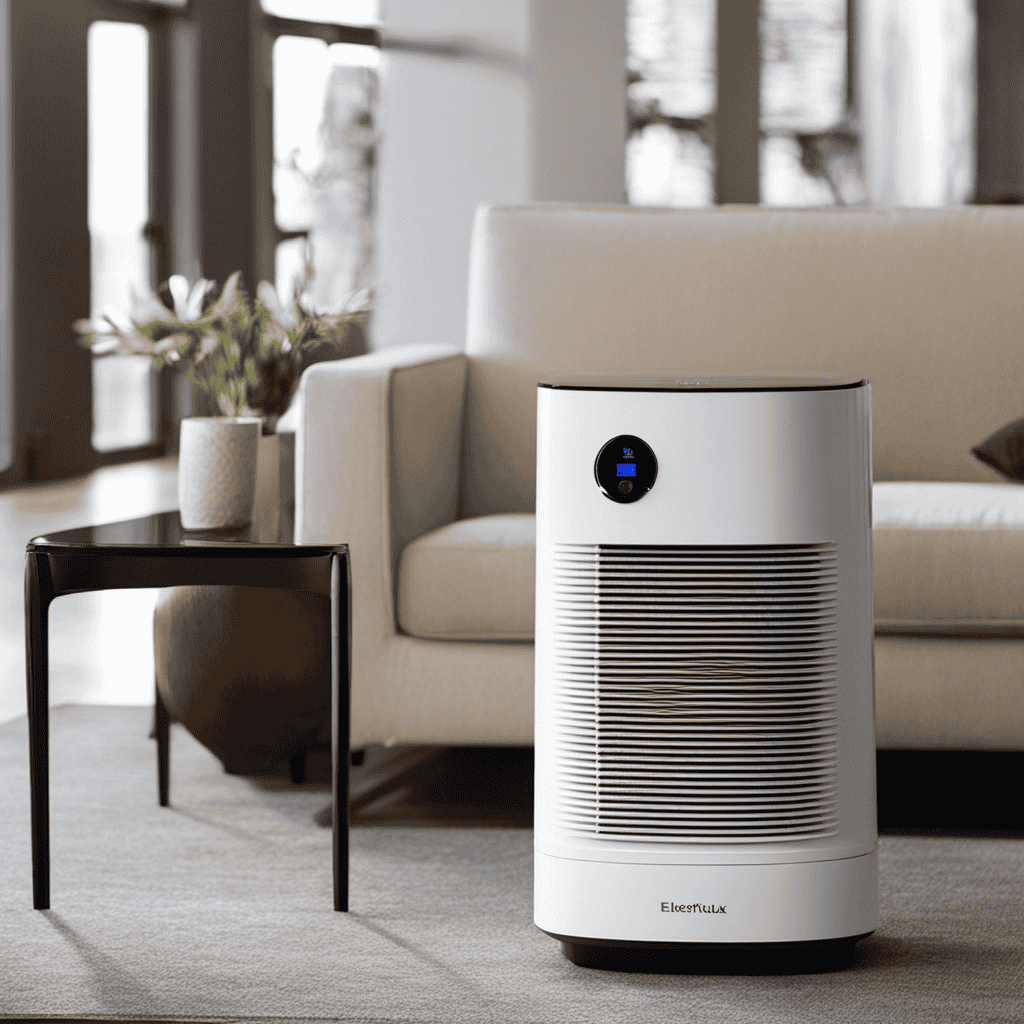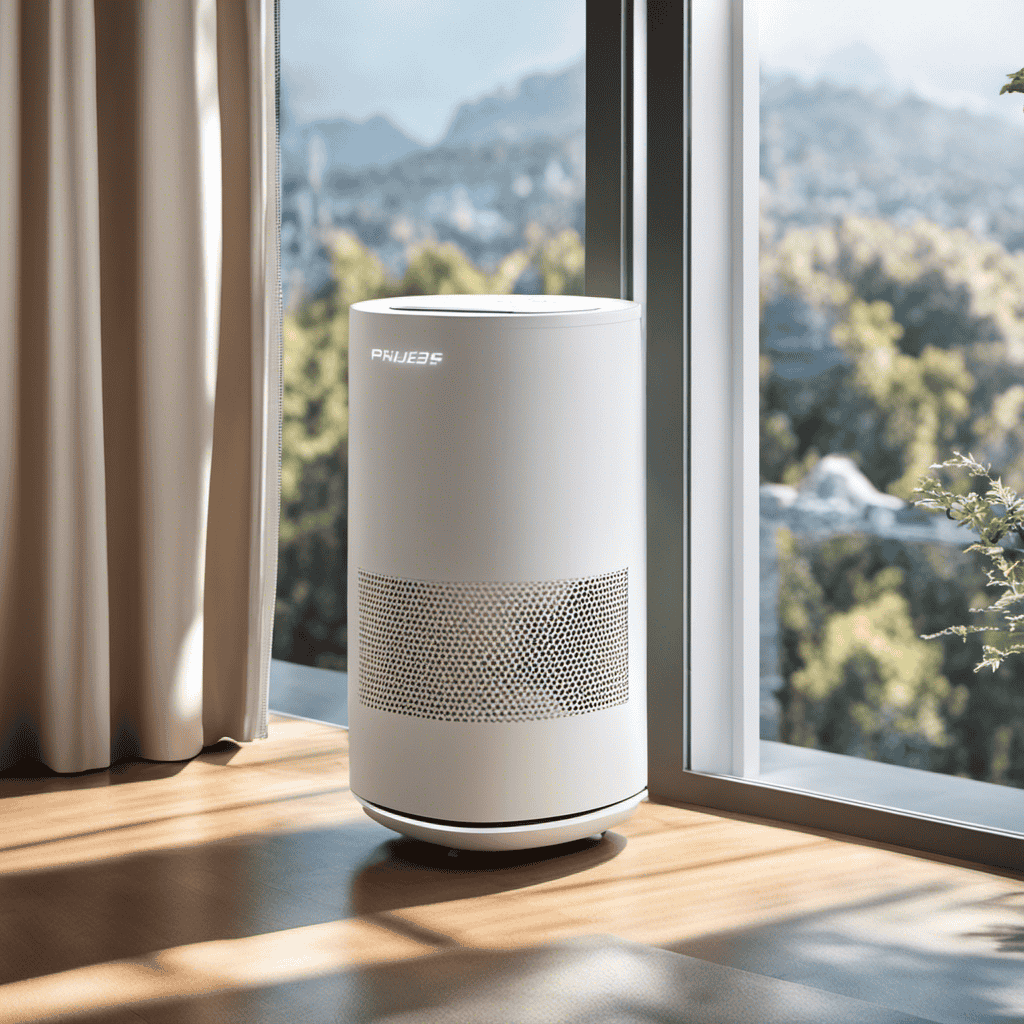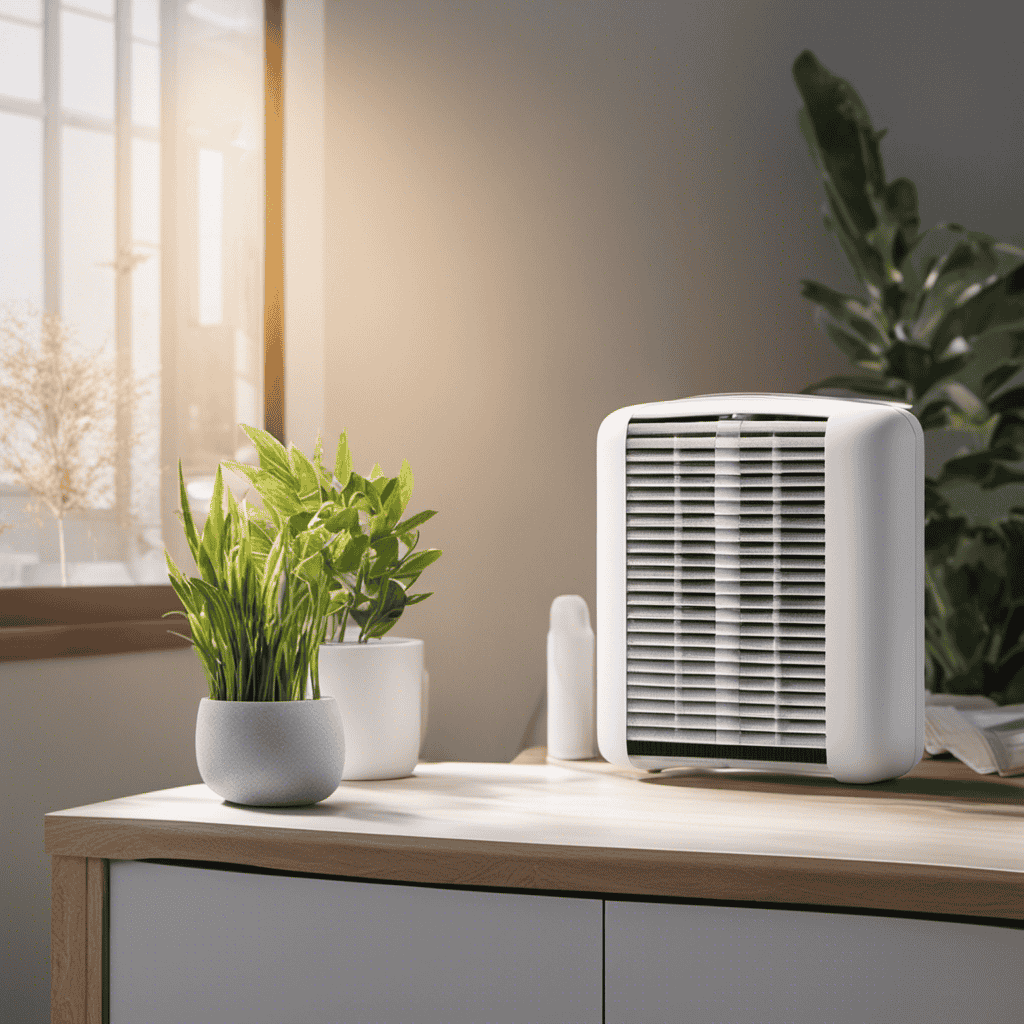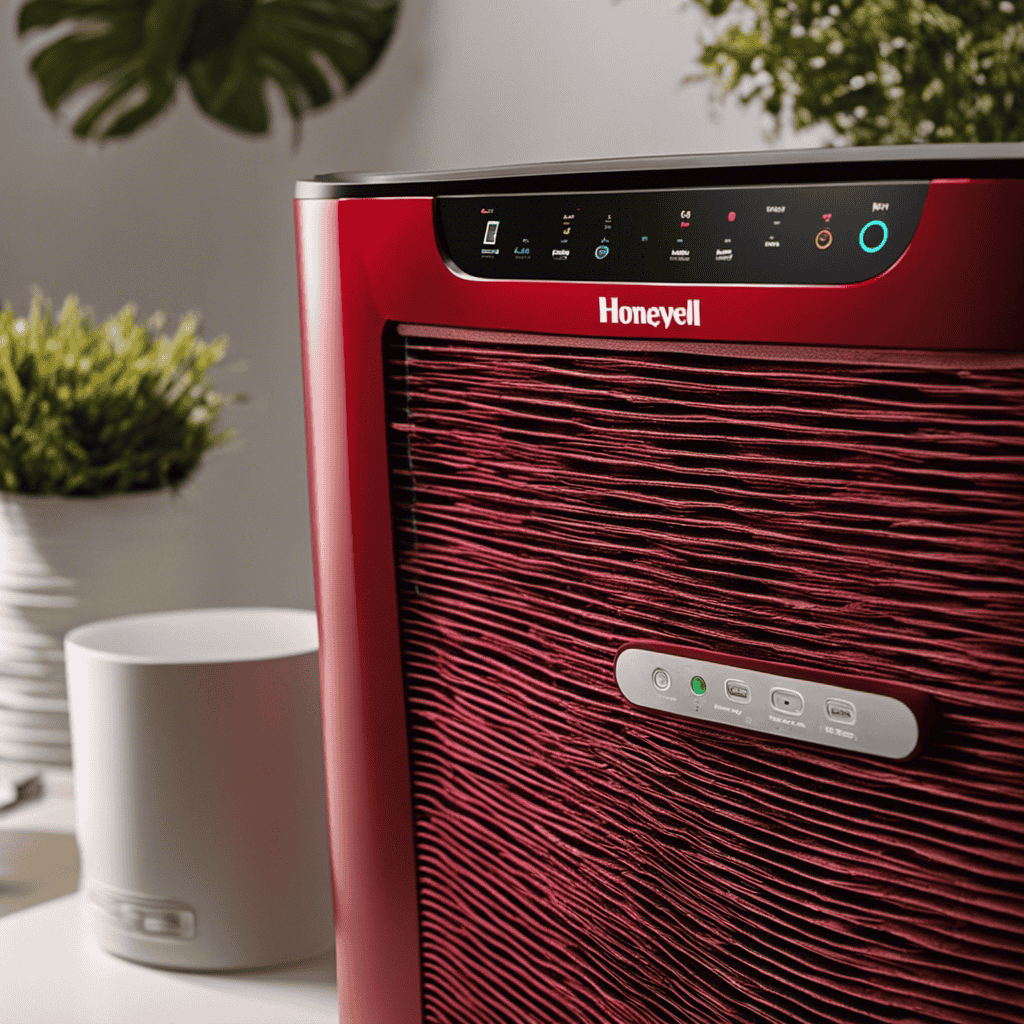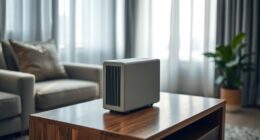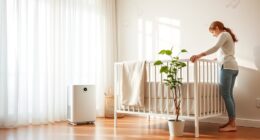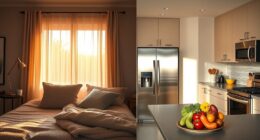I’ve perpetually been curious about how to efficiently operate an air purifier. Given the plethora of choices and functionalities at disposal, it becomes quite daunting to determine the optimal approach to enhance the quality of indoor air.
In this article, I will guide you through the process of choosing the right air purifier, understanding filters, setting up, operating modes, maintenance, troubleshooting, and maximizing the benefits of your air purifier.
Let’s dive in and discover the secrets to breathing cleaner, fresher air in your home.
Key Takeaways
- Consider the size of the room
- Take into account the air quality measurement
- Choose the right location for the air purifier
- Regularly clean and maintain the filters and pre-filter
Choosing the Right Air Purifier
When choosing the right air purifier, it’s important to consider the size of the room. Different purifier brands offer models that are suitable for different room sizes. To ensure optimal air purification, the purifier should be able to effectively cover the entire area of the room.
Additionally, it is crucial to take into account the air quality measurement in the room. This can be determined using devices such as air quality monitors or by consulting professionals. Understanding the current air quality in the room will help in selecting an appropriate air purifier with the right filtration capabilities.
Now that we have discussed the importance of choosing the right air purifier based on room size and air quality measurement, let’s move on to understanding air purifier filters.
Understanding Air Purifier Filters
To understand how your air purifier operates effectively, it’s essential to grasp the function of its filters. Air purifier filters play a crucial role in removing contaminants from the air, ensuring cleaner and healthier indoor air quality.
Here are five key aspects to know about air purifier filters:
-
HEPA Filters: High-Efficiency Particulate Air (HEPA) filters are widely used in air purifiers due to their exceptional ability to capture particles as small as 0.3 microns, including allergens, dust, and pet dander.
-
Activated Carbon Filters: These filters are effective in removing odors, smoke, and chemicals from the air. The activated carbon absorbs and traps these unwanted substances, improving the overall air quality.
-
Pre-Filters: Pre-filters act as the first line of defense, capturing larger particles like dust and hair. They help prolong the lifespan of the main filters by preventing them from getting clogged too quickly.
-
Maintenance: Regular maintenance is essential for optimal performance. This includes replacing filters as recommended by the manufacturer and cleaning or vacuuming pre-filters to remove accumulated debris.
-
Technology Advancements: With advancements in air purifier technology, some filters now incorporate antimicrobial coatings or UV-C light to further enhance their ability to kill bacteria and viruses.
Understanding these aspects of air purifier filters will help you maintain and maximize the efficiency of your air purifier, ensuring cleaner air for you and your family.
Setting up Your Air Purifier
Setting up your air purifier is a simple process that can greatly improve the air quality in your home. Air purifiers are designed to remove pollutants and allergens from the air, providing numerous benefits for your health. They can help reduce asthma and allergy symptoms, eliminate unpleasant odors, and even decrease the risk of respiratory infections.
To set up your air purifier, follow these steps:
-
Choose the right location: Place your air purifier in a central area of your home for maximum effectiveness.
-
Plug it in: Connect your air purifier to a power source using the provided cord.
-
Turn it on: Set your desired fan speed and let the air purifier do its job.
Operating Modes and Settings
In order to optimize your experience, familiarize yourself with the various operating modes and settings available to you. Understanding how these different modes work and knowing the recommended air purifier settings can help you get the most out of your device. Here are five important aspects to consider:
-
Auto Mode: This setting allows the air purifier to automatically adjust its fan speed based on the air quality in the room.
-
Sleep Mode: Designed for nighttime use, this mode operates silently and dims the lights on the purifier.
-
Timer: Set a specific time for the air purifier to turn on or off, which can be convenient if you want it to run only during certain hours.
-
Fan Speed Control: Adjust the fan speed to either low, medium, or high depending on the level of pollutants in the air.
-
Filter Replacement Indicator: This feature alerts you when it’s time to replace the filter, ensuring that your air purifier continues to work effectively.
Maintenance and Cleaning Tips
Keep in mind that regular maintenance and cleaning are essential for ensuring the longevity and efficiency of your device.
When it comes to cleaning your air purifier, there are a few techniques that can help you maintain its performance. Firstly, make sure to clean the pre-filter regularly, as it captures larger particles and prolongs the lifespan of the main filter. You can vacuum or rinse the pre-filter, depending on the manufacturer’s instructions.
Additionally, it’s crucial to replace the filters as recommended by the manufacturer. This will ensure that your air purifier can effectively remove pollutants from the air.
By following these cleaning techniques and replacing filters as needed, you can optimize the performance of your air purifier and improve your indoor air quality.
Now, let’s delve into how an air purifier can help in improving indoor air quality.
Improving Indoor Air Quality With an Air Purifier
When it comes to improving indoor air quality, there are different options to consider. One option is using an air purifier, while another is relying on natural ventilation. Both methods have their advantages and it’s important to understand their impact on respiratory health.
Here are some key points to consider:
-
Air purifiers: These devices are designed to remove pollutants from the air, such as dust, pollen, and pet dander. They use filters to trap these particles, improving the overall air quality in a room.
-
Natural ventilation: Opening windows and doors allows fresh air to enter and circulate, removing stale air and pollutants. This method can be effective in reducing indoor air pollution.
-
Respiratory health: Studies have shown that using air purifiers can help reduce symptoms of respiratory conditions like asthma and allergies. They can also provide relief to those suffering from respiratory infections.
-
Air purifier vs. natural ventilation: While both methods can improve indoor air quality, it’s important to consider factors such as outdoor air quality, weather conditions, and personal health needs when deciding between the two.
-
Combination approach: In some cases, a combination of air purifiers and natural ventilation may be the most effective way to improve indoor air quality and promote respiratory health.
Troubleshooting Common Issues
When it comes to troubleshooting common issues with an air purifier, there are a few key points to consider.
Firstly, understanding the filter replacement frequency is crucial in maintaining the effectiveness of the purifier.
Secondly, eliminating strange odors is a top concern, and knowing the necessary steps to take can make a significant difference.
Lastly, power supply problems can hinder the functionality of the air purifier, so identifying and addressing any issues in this area is essential for optimal performance.
Filter Replacement Frequency
Make sure you’re aware of how often you should replace the filter in your air purifier. Proper maintenance is crucial to ensure optimal performance and clean air quality. Here are some key points to consider regarding filter replacement schedule and extending filter lifespan:
-
Check the manufacturer’s guidelines: Each air purifier may have different recommendations for filter replacement. It’s important to follow the specific instructions provided by the manufacturer.
-
Monitor the filter condition: Regularly inspect the filter for signs of dirt, dust, or discoloration. If the filter appears dirty or clogged, it’s time for a replacement.
-
Consider the air quality: If you live in a highly polluted area or have pets, you may need to replace the filter more frequently to maintain effective filtration.
-
Use pre-filters: Pre-filters can help capture larger particles and extend the lifespan of the main filter. Make sure to clean or replace pre-filters regularly.
-
Clean the filter: Some air purifiers have washable filters. Follow the manufacturer’s instructions to clean and maintain the filter properly.
By adhering to a filter replacement schedule and implementing these tips, you can ensure that your air purifier operates efficiently and effectively eliminates contaminants from your indoor air.
Now, let’s move on to the next topic: ‘strange odor elimination’.
Strange Odor Elimination
To effectively eliminate strange odors, you should consider using activated carbon filters in your air purifier.
Activated carbon filters are highly effective in removing a wide range of odors, including those from cooking, pets, smoke, and chemicals.
These filters work by trapping odorous molecules in the carbon’s porous structure, preventing them from recirculating into the air.
The unique properties of activated carbon allow it to adsorb and neutralize even the most stubborn odors, providing you with cleaner and fresher indoor air.
When selecting an air purifier with activated carbon filters, make sure to choose one that has a sufficient amount of carbon and a high-quality filtration system.
This will ensure optimal performance and long-lasting odor elimination.
With activated carbon filters, you can enjoy a comfortable and odor-free living space.
Power Supply Problems
If you’re experiencing power supply problems, it’s important to check the circuit breaker first. This is a common issue that can easily be resolved.
Here are some troubleshooting steps to help you identify and fix power supply problems:
-
Check the circuit breaker: Make sure it is in the ‘on’ position and not tripped.
-
Inspect the power cord: Look for any signs of damage or fraying.
-
Test the outlet: Plug in another device to see if the outlet is working properly.
-
Reset the air purifier: Sometimes, a simple reset can fix power supply issues.
-
Contact customer support: If none of the above steps work, reach out to the manufacturer for further assistance.
Maximizing the Benefits of Your Air Purifier
When it comes to maximizing the benefits of your air purifier, two key points to consider are optimal placement for effectiveness and regular filter maintenance.
Proper placement of the air purifier is crucial in ensuring that it can effectively remove pollutants from the air.
Additionally, regular filter maintenance is essential for maintaining the efficiency of the purifier and prolonging its lifespan.
Optimal Placement for Effectiveness
The best place to put the air purifier is in a central location, like the living room or bedroom. Placement considerations play a crucial role in optimizing the airflow and maximizing the effectiveness of the air purifier. Here are some key points to keep in mind:
- Avoid placing the air purifier near walls or furniture as it can hinder the airflow.
- Ensure that there is enough space around the air purifier for proper circulation.
- Place the air purifier at a height where it can effectively capture pollutants in the air.
- Consider the size of the room when selecting the air purifier to ensure adequate coverage.
- If you have multiple floors, it is recommended to have an air purifier on each level for comprehensive purification.
By carefully considering these placement considerations, you can optimize the airflow and enhance the performance of your air purifier.
Now, let’s move on to the next section about regular filter maintenance.
Regular Filter Maintenance
To keep your air purifier running efficiently, you’ll need to regularly clean or replace the filters. Filters are an essential component of air purifiers as they trap and remove particles from the air, improving the indoor air quality. Over time, filters become clogged with dust, pollen, pet dander, and other pollutants, reducing their effectiveness. Regular filter maintenance is crucial to ensure optimal performance and prolong the lifespan of your air purifier.
To help you understand the importance of filter replacement, here’s a table showcasing the recommended frequency of cleaning or replacing filters based on the type of filter and usage:
| Filter Type | Cleaning Frequency | Replacement Frequency |
|---|---|---|
| Pre-Filter | Every 1-2 months | Every 6-12 months |
| HEPA Filter | Every 6-12 months | Every 1-2 years |
| Carbon Filter | Every 6-12 months | Every 1-2 years |
| Ionizer | Every 1-2 months | N/A |
| UV-C Light Bulb | N/A | Every 1-2 years |
Frequently Asked Questions
Can an Air Purifier Remove All Types of Indoor Air Pollutants?
Yes, an air purifier can remove a wide range of indoor air pollutants. Its effectiveness depends on the specific model and the pollutants present, but common pollutants like dust, pollen, pet dander, and mold spores can typically be filtered out.
How Often Should I Replace the Filters in My Air Purifier?
I recently learned about air purifier maintenance and the importance of replacing dirty filters. It’s recommended to replace filters every 3-6 months, or when you notice reduced airflow or dusty surfaces.
Can I Use an Air Purifier in Multiple Rooms of My House?
Yes, you can use an air purifier in multiple rooms of your house. It has many advantages, such as removing allergens, dust, and odors. Contrary to common misconceptions, air purifiers do not generate harmful ozone.
Is It Safe to Leave an Air Purifier Running Overnight?
Leaving an air purifier running overnight can be safe, as long as you follow proper safety guidelines. Potential dangers include fire hazards and overworking the unit. However, the benefits of using an air purifier overnight can outweigh these risks.
How Long Does It Take for an Air Purifier to Clean the Air in a Room?
To clean the air in a room, an air purifier needs time. The duration depends on factors like room size and air quality. Choosing the right size air purifier and using it at home has numerous benefits.
Conclusion
In conclusion, I must say that operating an air purifier is a truly exhilarating experience. It’s like having your own personal superhero, fighting off invisible villains called pollutants.
With the right air purifier, you can transform your home into a sanctuary of clean and fresh air. Remember to choose the purifier wisely, understand its filters, and set it up with utmost care.
Don’t forget to perform regular maintenance and troubleshooting, because even superheroes need a little TLC.
So go forth, my friends, and enjoy the wonders of clean air!


